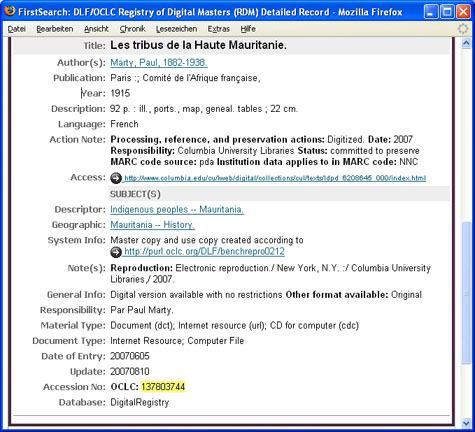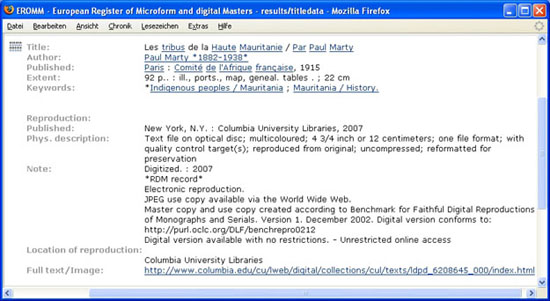Since the invention of printing the spread of ideas and knowledge has been in the mind of authors when publishing their work in the new medium. The aim to make a profit from printing and distributing was naturally in the mind of producers and distributors, i.e., printers, publishers and book traders. To achieve this they needed to make their products known as widely as possible. And they used the new medium itself for this purpose.
In 1628 the book trader Grosius in Leipzig reprinted and updated his list of books on sale. On its last page his Catalogus Librorum has an entry which reads, ‘Nicolai Reymeris Geodæsia Ranzoviana, von Landrechnen und Feldmessen / in 4’. This is one of the earliest works by Nicolaus Reimers, well-known astronomer and mathematician, which was printed in the same town in 1583. Continuous advertising of the book has helped to sell it widely. Today, under the title ‘Geodæsia Ranzoviana’ we are able to discover 10 print copies by using just one popular search tool (KVK[1]). A few more copies can surely be found after more thorough searching. Still what we can find using bibliographical databases or search engines will certainly only constitute a partial selection of the copies existing to our day.

Figure 1
The KVK returned 6 hits (=10 print copies and 1 microfilm) found at
-
Bibliothèque nationale de France, Paris
-
Bayerische Staatsbibliothek, München
-
Herzogin-Anna-Amalia-Bibliothek, Weimar
-
Herzog-August-Bibliothek, Wolfenbüttel
-
Österreichische Nationalbibliothek, Vienna
-
Staatsbibliothek zu Berlin–Preußischer Kulturbesitz, Berlin
-
Thüringer Universitäts- und Landesbibliothek, Jena
-
Technische Informationsbibliothek und Universitätsbibliothek Hannover, Hannover Zentralbibliothek, Zürich
One copy was probably lost through bombing in 1944 (Berlin), another is a likely loss caused by fire in 2004 (Weimar).
Just as the book printed in 1583 is found in libraries in our day? To raise this question today may seem as premature as asking whether someone will advertise it 45 years after production. But without doubt, you and those funding your work are not making all this effort to digitise a work in order to lose the digital version after a few years’ time. So there clearly are questions that need to be asked:
-
What do you need to do to make your digital copy last? First of all you have to choose a format that will be susceptible to future attempts of refreshing without losing content and quality. In particular this requires bridging the obstacles posed by ceaselessly renewed features of hardware and software. Second, there must be a reliable digital repository, safe and capable of dealing with a large quantity of data. Third and most important, you will need considerable funding not only to produce your digital document but also to keep things running and alive in the long-term.
-
Will your funding come forward and subsist? (Although I am talking about libraries of the public sector primarily, some aspects are true for the private sector as well.) Today it is easy to convince your organisation and funding bodies of the attractiveness of digitisation, especially if you do not tell them of future costs for the upkeep of the digital library.[2] But by now, we can already see that digitising is rapidly becoming something of normality. More and more people tend to take it for granted that someone is offering a beautifully produced version for access on the web. Funding bodies will understand that somebody has to pay for production and maintenance. However, it is becoming more difficult than before to start new projects. One of the questions usually asked is whether the product is not offered by someone else. Some even want to know, whether you have checked possible parallel projects aiming at doing the same thing. Finally there is the question about proceeds that can be expected from offering the product to the general audience. It all comes up to the question, ‘Will it be worthwhile to digitise a book yourself?’
It is relatively easy to secure funding for a project that is limited in time and will show nice results soon. Libraries and other memory institutions, however, cannot be satisfied with short-term support alone. They have to provide access to their digital holdings for this and future generations.
This requires a step-by-step approach. It is important first to secure visibility of what you have produced already and point to its quality and user friendliness to get a good response from local and national audiences and users beyond your country's boundaries. The uniqueness of your selection of digitised works on the one hand and the smooth integration of your digital service with the local library and information system on the other should be demonstrated. You may point out the possibility of exchanging information through European and international networks as a way to strengthen your position as a provider of digital content.
All this will support your request for continuous funding as a precondition for sustained availability of digital content. A funding body can be assured that investment in your digitisation activity will not be lost.
Publications not known to the relevant audience will rarely be used. Unused works tend to be neglected physically and are susceptible to getting lost. This is true for library holdings of any kind. Thus, any effort to make a digitised work visible and accessible involves an aspect of preservation. Visibility in a way can be seen as indispensable for survival of the item.
The electronic catalogue in its modern technical setting is the best tool when it comes to integrating multiple functions and achieving the broadest possible visibility. This sounds rather old-fashioned after all the trendy tools that we are making use of today. But in fact, many of the systems that allow us to trace a publication on the internet with some reliability originate from bibliographic databases of some kind, most of them catalogues.
A digital library may offer the most sophisticated options for retrieval, such as full text searching of OCR’ed, digitised books. It may also have a superb layout and user-friendly tools for browsing and reading. However, you will be aware that the content of the digital library is nothing but a very minuscule portion of what the conventional library holds. The latter has the mass of material and it will take quite some time until digitisation will have covered only the most important works it contains.
The user, as a rule, is not just browsing for fun, but is looking for items he needs in his research or study. This is why he must start from the resource that offers the broadest information about the library’s holdings. There he will discover that the item he is looking for is available in digitised format as well. A click should carry him to the item in the digital library, where he will be able to enjoy all the advanced features of this setting. To inform the user, you have to make sure that bibliographic reference to the digitised work is present in the OPAC. Easy access from here is just as important as is its quality as a digital object.
There are also more general benefits of recording digitised works in the library catalogue. Through the networked OPAC you will not only reach the local, but also the national and international audiences. The uniqueness of your digitised works will become transparent when the library catalogue’s information is made available through union catalogues and search portals. Electronic catalogues are the dominant user interface when it comes to precise searching. A lot of other services of the local library and information system relate to it. So there is no reason why the digital library service should not do the same.
Exchanging catalogue information through European and international networks is a well-established practice. Information about digital content provided by your library or project will be carried along without any additional effort on your part. Intelligent use and integration of digital content from other providers can be supported by the OPAC. Increased usage of the digitised material will support any requests for funding the sustained availability of the digital library.
In spite of modern technology, the content of European digital libraries is only partly accessible through catalogues. This is easily visible when searching EROMM, the European Register of Microform and Digital Masters.[3] This database holds 15,966 records of digitised books and periodicals (995 of the total) from European sources (October 2007). This is less than half of the estimated production to date. The total number of digital masters in EROMM comes to 46,248 because of the contribution by the American partners, RLG and OCLC.[4]
Although the European hesitation towards recording digitised items in library catalogues is not visible in America, there is still a certain delay in supplying catalogue information. The Digital Library Federation[5] observed that it is at present impossible to tell with certainty what has been digitised, what the technical features of digital masters are and who will take care of their long-term preservation. Experts called upon by the DLF proposed to create a Registry of Digital Masters[6] as a specialised resource, open to everyone. The criteria for what the RDM should record were defined, and OCLC created this bibliographic database, which is online since last year.
There is no sense in creating a national resource for American digitisation activities alone. Indeed, libraries world-wide shall contribute to the RDM. In 2006, OCLC and EROMM signed an agreement of cooperation with LIBER as the primary signatory, which supports this initiative pledging to work for cooperation throughout Europe.[7] The agreement provides for the mutual exchange of records of digitised works.[8] This is the continuation and expansion of the exchange of data that went on between RLG and EROMM for the last ten years. A few technical issues remain to be resolved, but RDM records are visible in the EROMM database already.

Figure 2: Example of a record from the Registry of Digital Masters (RDM).

Figure 3: The same record as shown in EROMM.